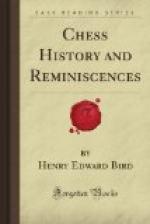It may be also that on further consideration of the Roman edict and references to their games, and the accounts relating to the fourth century B.C., many will be indisposed to accept the dictum that Herodotus, Plato and Aristotle meant nothing more than a game of pebbles, when they referred to chess and propounded their theories as to its invention.
------
PERSIA
“Khusra Anushirawan” Naushirawan or Chosroes as he is more frequently called, being the Byzantine title applied to him, was King of Persia and reigned 48 years, from 528 to 576 as stated by some authors, or from 531 to 579 according to others. He is described also as Chosroes the Just. The receipt of chess in Persia from India early in his reign, and the great appreciation and encouragement of it, is the best attested fact in chess history, if not really the only one as to which there is entire concurrence in opinion among all writers.
The Persian and Arabian historians are unanimous that the game of chess was invented in India, some time previous to the Sixth century of our Era, and was introduced into Persia during the reign of Kisra Naushirawan, the Chosroes of the Byzantine historians, and the contemporary of Justinian, they differ only as to the time of its modification, some ascribing it to about this period, and others to that of Alexander the Great, 336 to 323 B.C.
Although several works concur in stating that chess first came to Persia from India, through Burzuvia the physician, most learned in languages with the materials of the book called Culila Dimna, quite early in Chosroes’ reign, some think differently and attribute Burzuvia’s mission to India and return to a late date. It is related from the Shahnama, the great Persian poem that it came from Kanoj, Kanauj, commonly written Canoge, by means of a magnificent embassy from the King of Hind, accompanied by a train




